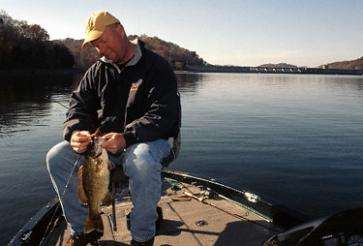
Last week we ran a Q&A on some of the most common questions I get about fishing the float-and-fly. Now I want to dig a little deeper and get a little more specific about some of the details that will make you more successful with this great technique.
First of all, we should cover the best time of year to use the float-and-fly. After years and years of using the method, I’ve determined that it works best whenever the water temperature is below 55 degrees. That’s when the shad and other baitfish seem to congregate and suspend at the levels that can best be reached by the float-and-fly, and it’s when the bass seem to be holding just under these schools and poised to target the bait. I’ll never say that the float and fly won’t work at other times — it certainly will — but when the water temperature is below 55, you’re going to have the best success with it.
Once you’re all rigged up and ready to give the method a try, the most important tackle decision you’ll make is the depth at which to suspend your fly or jig. Finding the right depth is absolutely critical to your success, and the best way to make that determination is through the proper use of your electronics.
As you start looking for an area to fish, keep one eye on the screen of your depthfinder. You’re not looking for bass, not just yet anyway. You want to find big schools of shad or other bait, and you want to pay particular attention to the depth at which you find them. Usually it will be a range of several feet that represents the top and bottom of the school. For the sake of our example, let’s just say that the range is 10 to 13 feet.
Once I know the bulk of the baitfish are holding between 10 and 13 feet, I know where I want to set my float and how long my leader needs to be. I always try to use a leader that will suspend my jig at the bottom level of the baitfish. That way the bass will get a better look at it and it will be easier to target. There’s no need to make the bass swim through all those baitfish before they get a look at your jig.
Another thing that will add more bass to your catch is making your presentation more subtle. A marabou, flashabou or modacrylic jig has lots of action in the water; real baitfish do not at this time of the year. You need to mute that action if you want your jig to appear more lifelike and realistic to the bass.
To do that, I use a product that we make at Punisher Lures. It’s called Fish Dope and it’s a petroleum jelly-based paste that is mixed with scents. I smear enough of the Fish Dope on the jig skirt material to make it look stiff and almost actionless. This will help you make your bait look more lifelike in the cold water.
If you get the depth right and properly mute the action on your jigs, you’ll definitely catch more bass.
It’s going to make you a better smallmouth angler.
Until next time, if you have any questions or comments, I’d love to hear from you. Please e-mail me atStephen@thesmallmouthguru.com.





